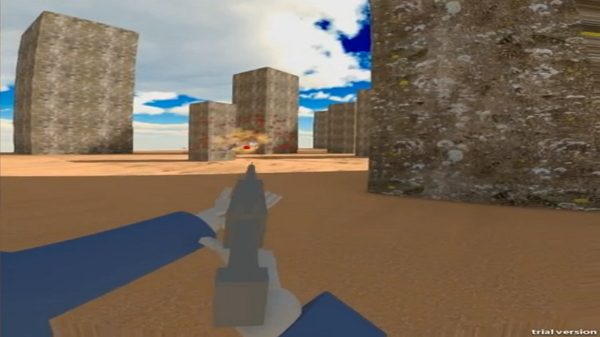While a number of games plan on supporting the Oculus Rift head mounted display, not many of them are being made specifically for it. Owen Pedrotti has a functional prototype of a virtual reality game that he is making to take full advantage of the Rift. Combined with the Razer Hydra, a high-fidelity motion tracking peripheral, Pedrotti hopes to immerse players in an intense mech-style first person shooter complete with up-close and personal melee combat. I spoke with Pedrotti to learn about his prototype Oculus Rift virtual reality game.
See Also: List of Oculus Rift Compatible Games
Pedrotti stressed that the game, which is tentatively named ‘Armored Ops’, is a prototype and work-in-progress. What you’re about to see is a very early mock-up of where he hopes to take the game. Even in its prototype stage I think it’s clear that he’s onto something great:
Custom Engine Tuned for Virtual Reality Immersion
Currently the prototype is built in the Unity engine (which will be natively support when the Oculus Rift SDK launches), but he tells me that he will be building his own game engine to make sure the game achieves the level of virtual reality immersion that he wants.
“I intend to build my own engine… this prototype came up against the limits of what Unity can handle. They don’t expose a lot of important APIs in DirectX and Physx which I could use to make the game run faster and look better. With immersion as the main goal of VR, I want to use every trick I know to improve the sense of realism. And Physx itself was not really made for simulating complex robots, so I will probably use something like Open Dynamics Engine so that I can handle more joints without losing stability,” he said.
Pedrotti, who backed the Oculus Rift Kickstarter for two units to test multiplayer gameplay, hasn’t had a chance to try his prototype with the Rift itself. He showed his demo to some members of the MTBS3D forum; one member, who built their own Rift, watched the demo and commented, “This looks amazing… VERY intense when the bots head is chopped off and spirals to the ground. Also the sense of depth when the laser pointers are being used is simply amazing. Outstanding work and I look forward to seeing the progress!”
Pedrotti has been in game development professionally for several years, mainly working with graphics in Unity. He says he’s built game engines on the side for several years (what else would you expect a developer to do in their free time?!). He sounded very excited about the immediate future of gaming when I asked him why who chose to work on this project.
“Virtual reality is a big part of the reason I got into game development, and I have been looking frequently since the 90s for a head mounted display that actually works for gaming. Games like MechWarrior 2 really got me thinking about how it would feel to be immersed in a 3D simulation, and I have been wanting to create that kind of experience ever since. This is the first time I feel that its really within reach.”
The “Best Next Step” for Virtual Reality Games
One of the big promises of the Nintendo Wii was that it would finally let players have compelling sword-fights… unfortunately this didn’t quite pan out. With no way to incorporate force-feedback (preventing players from swinging through opponents and other objects) sword fighting in Wii titles was rarely little more than gestures turned into button presses.
Pedrotti, who says that the Razer Hydra is the “best next step” for virtual reality gaming input, is carefully tuning his game to ensure that lack of force-feedback isn’t a problem. For one, if you don’t get enough momentum in your swing, your sword will bounce off of the opponents armor. This ensures that players will make deliberate swings and render random flailing of the remotes useless (preventing yet another issue common with Wii controls). When it comes to blocking incoming sword swipes, the precise position of your sword is important; blocking toward the hilt of the sword is better than at the tip because you’ll have more leverage against the enemy’s swing.
“The Razer Hydra was something of a surprise for me. It’s proven to be pretty close to ideal for my purposes, and has taken my MechWarrior inspired game design in what I think is a more interesting direction. It matched perfectly with the physics-driven robot simulation I created for controlling the arms.”
While the Hydra might be a solid virtual reality input solution, it doesn’t come without challenges.
“The biggest hurdle technically with the Hydra will be making it match up with the sensors in the Rift. It’s vitally important for your virtual hand to be in the right place relative to where you are looking, and the sensor package currently being shown with the Rift has problems with rotation drift. The Hydra also requires you to stay close to a base station, ideally facing toward it. My game design works with this limitation by having you as a pilot sitting in a cockpit (who is also using an HMD and hand tracking controls),” he said.
I’ll be keeping a close eye on Pedrotti’s progress and can’t wait to give it a try once they Oculus Rift arrives. Stay tuned!
See Also: Project Holodeck Combines the Oculus Rift and Razer Hydra for a Full-body Virtual Reality Platform







